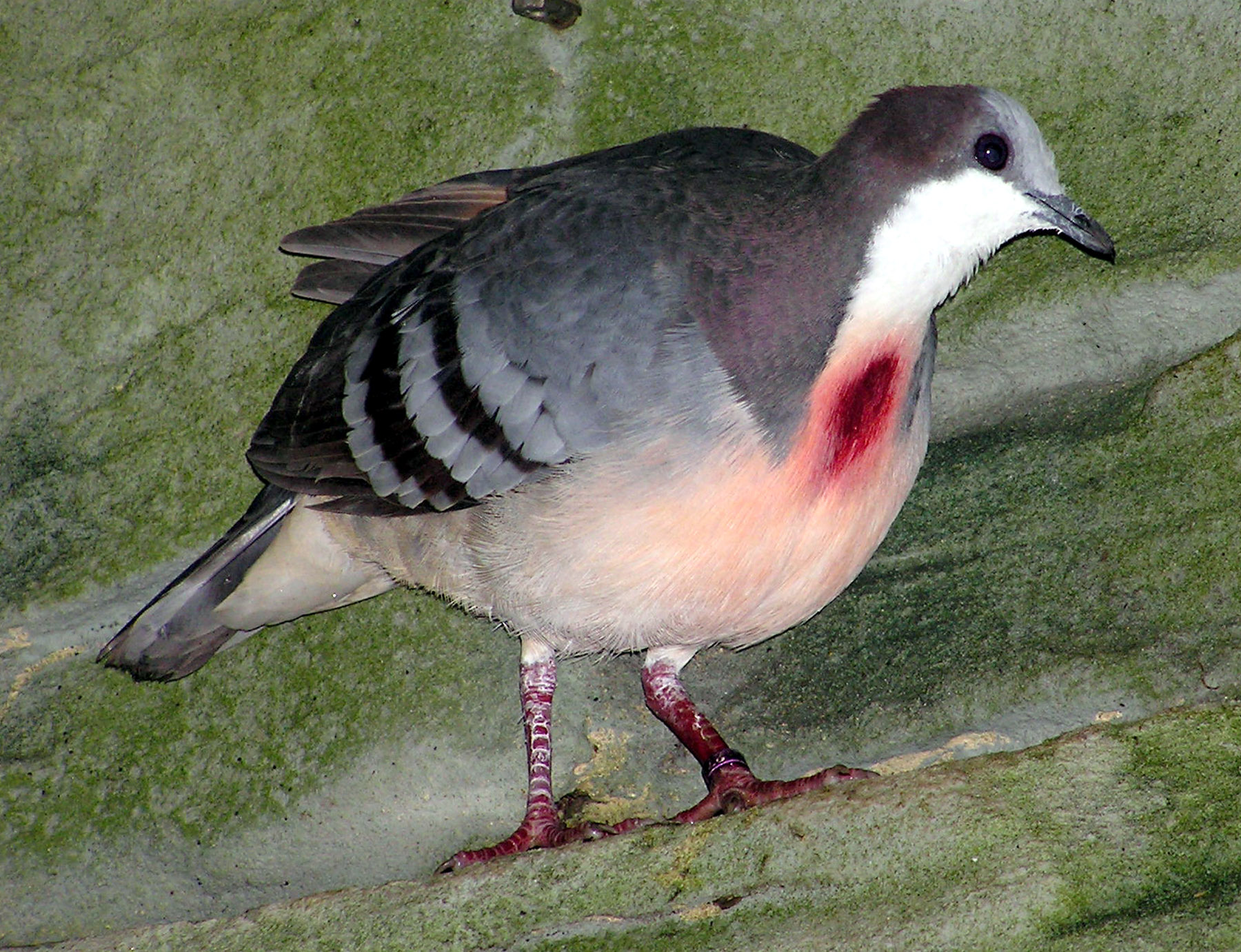- Gallicolumba
image_size=300
image_caption=Luzon Bleeding-heart , "Gallicolumba luzonica"
regnum =Animal ia
phylum =Chordata
classis =Aves
ordo =Columbiformes
familia =Columbidae
genus = "Gallicolumba"
genus_authority = Heck, 1849
subdivision_ranks = Species
subdivision = "see article text"
synonyms =
* "Phlegoenas"
Reichenbach, 1852Gallicolumba is a
genus of ground-dwellingdove s which occur in rainforests on thePhilippines ,Indonesia , and in thePacific region. This include the Ground-doves from the Pacific islands and the Bleeding-hearts known from the Philippines. The latter are named thus for a vivid-red patch on the breast which looks startlingly like a bleeding wound in some species; it reminded naturalists of adagger stab. The diet of doves of this genus consists of fruits and seed.ystematics
Currently about 20 species are extant. Of the larger genera of
Columbidae , "Gallicolumba" is the one most affected byextinction . 3-4 species have disappeared since the 18th century, and most of the remaining are decreasing in numbers, threatened with extinction or have lost subspecies due to habitat destruction, invasive species, or overhunting. In addition, there are several species never studied alive but known fromsubfossil bones. These became extinct during the human settlement of the Southern Pacific region (c. 3000 BC - 1400).The bones of "Gallicolumba" are distinct enough to usually recognize this genus with ease. Still, the evolutionary affiliation of extinct species is often uncertain. Especially, most extinct Polynesian taxa occur in the area where the white-headed ("G. jobiensis", "G. erythroptera") lineage and the
Melanesia n expansion that brought about "G. sanctaecrucis" and "G. stairi", and possibly "G. rubescens", would have met.*
Luzon Bleeding-heart , "Gallicolumba luzonica"
**Catanduanes Bleeding-heart, "Gallicolumba luzonica rubiventris" - possiblyextinct (late 20th century?)
*Mindanao Bleeding-heart , "Gallicolumba crinigera" ("criniger" is a spelling error in the description)
**Basilan Bleeding-heart, "Gallicolumba crinigera bartletti" - possiblyextinct (mid-20th century?)
*Mindoro Bleeding-heart , "Gallicolumba platenae"
*Negros Bleeding-heart , "Gallicolumba keayi"
*Sulu Bleeding-heart , "Gallicolumba menagei" - possiblyextinct (late 1990s?)
*Cinnamon Ground-dove , "Gallicolumba rufigula"
*Sulawesi Ground-dove , "Gallicolumba tristigmata"
*White-breasted Ground-dove, "Gallicolumba jobiensis"
**Vella Lavella Ground-dove, "Gallicolumba jobiensis chalconota" - possiblyextinct (late 20th century?)
*Norfolk Island Ground-dove , "Gallicolumba norfolciensis" -extinct (c.1800)
*White-throated Ground-dove , "Gallicolumba xanthonura"
*Rota Ground Dove, "Gallicolumba" sp. - prehistoric
*Caroline Islands Ground-dove , "Gallicolumba kubaryi"
*Polynesian Ground-dove , "Gallicolumba erythroptera"
**White-headed Polynesian Ground-dove, "Gallicolumba erythroptera albicollis" - probablyextinct (20th century); taxonomic status unresolved
*Great Ground-dove , "Gallicolumba nui" - prehistoric
*Henderson Island Ground-dove , "Gallicolumba leonpascoi" - prehistoric
*New Caledonian Ground-dove , "Gallicolumba longitarsus" - prehistoric
*Shy Ground-dove , "Gallicolumba stairi"
*Santa Cruz Ground-dove , "Gallicolumba sanctaecrucis"
*Tanna Ground-dove , "Gallicolumba ferruginea" -extinct (late 18th-19th century)
*Thick-billed Ground-dove , "Gallicolumba salamonis" -extinct (mid-20th century)
*Marquesan Ground-dove , "Gallicolumba rubescens"
*Bronze Ground-dove , "Gallicolumba beccarii"
*Palau Ground-dove , "Gallicolumba canifrons"
*Wetar Ground-dove , "Gallicolumba hoedtii"Further reading
*Gibbs, David; Barnes, Eustace & Cox, John (2001): "Pigeons and Doves". Pica Press, The Banks, ISBN 1-873403-60-7
*Steadman, David William (2006): "Extinction and Biogeography of Tropical Pacific Birds". University of Chicago Press. ISBN 0-226-77142-3
* del Hoyo, J.; Elliot, A. & Sargatal, J. (editors). (1997).Handbook of the Birds of the World . Volume 4: Sandgrouse to Cuckoos. Lynx Edicions. ISBN 8487334229
Wikimedia Foundation. 2010.

